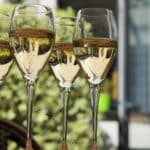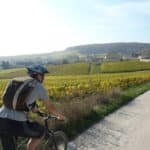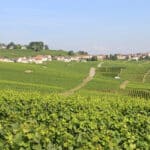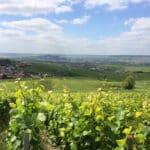When I’m on our bike tours, you can imagine I get asked a lot of questions about how we design our tours – why we stay here, why we don’t visit there, etc. Occasionally, in my own mind, I’m reminded of that old saying about laws and sausages – you don’t want to see how they’re made!
Did we not do enough research in the first place? Was the tour rubbish? In this case, the story is much less interesting than that.

When we carried out the research for a Champagne tour, in 2019 and 2020, our choice of hotel for Sunday night was the Relais de Fleurette in Pontavert. Lydia, as a local, visited the hotel and recommended it. I’d stayed there twice myself, and the owner / chef was renowned within the region, boasting awards from Logis de France for his restaurant. It was the best food I enjoyed anywhere in Champagne.
Since then there’s been a change of owner. And the new owner shouldn’t be allowed to own a hotel. Or to be within 50 metres of me ever again! And there really aren’t any options nearby. So we had to redesign the tour.
I’m delighted. The tour has changed dramatically. We’ve reduced the amount of climbing and the number of hills, we’ve reduced the distance, and we’ve radically changed our schedule of tastings.
I won’t bore you with the details (“Too late!”, “Shut up, Peter Taylor!”), they’ve been covered elsewhere (https://thechaingang.co.uk/cycle-tours/france/champagne/), but there are reasons why champagne struggles to be as good as its reputation. It’s a triumph of marketing over substance. But I’ve been won over.
We learned last year how hard champagne makers work to maintain the quality of their wines, despite rather than because of the region’s history. At Alfred Gratien in Épernay, for example, they explained how much effort goes into a constant quality assurance process with their dozens of grape suppliers. And better wine-making techniques combined with a bit of climate change mean that Champagne makers are working with riper grapes than historically. They don’t have to mess about with the wine so much, adding sugar, trying to maintain a fermentation.

Increasingly, small growers especially in the Cotes des Blancs, have been able to reduce the amount of sugar they add, in some cases to nothing. So these are proper wines – transformed into Champagne.
Something else that I found very interesting is that everywhere we got to compare the house champagne with one of their vintages, virtually everyone on both our Champagne trips preferred the house blend. A reminder that the ‘blender’ wasn’t some passing cyclist, but an oenologist who knows their wine-tasting onions! That’s a lesson that could save you a bob or two! Have that on me.

So this year we’ll aim to explore this better than previously. We will visit a couple of Grand Cru vineyards on Monday, in Le Mesnil-sur-Oger and in Cramant, as we roll down the Cotes des Blancs on our way into Épernay.
To the East of Épernay, on the southern slopes of the Montagne de Reims, we’ll find the Marne Valley’s finest wine-makers in Aÿ, but we’ll also follow the Marne downstream towards Paris. The vines on either side of the River Marne here are (almost) all Pinot Meunier, because Chardonnay and Pinot Noir won’t ripen along the banks of the Marne once you get downstream from Épernay (that’s knowledge, that is! Right there!). And we’ll taste in Boursault on our way back to Épernay.

In Épernay and Reims, we’ll visit a couple of the grander Houses with their magnificent cellars, and on our last day of cycling, as we cross the Montagne de Reims, hotbed of Pinot Noir, we’ll a couple of smaller vineyards. Full details on the website, go and have a look.
Sorry, winemakers of Champagne. You’ve convinced me, I won’t be rude about you again.


